February may seem like a strange time to think about cider, or even autumn. But when Mother Nature seduces us on a Friday with the sweet smell of spring, then turns her back days later with a sick smack of sleet, I’m happy to exercise a flagrant disregard for the season. More importantly however, we’re about 8 months out from the peak of autumn, the same amount of time it takes to make a seriously strong batch of hard cider, which makes this the perfect time to start brewing.
I had never seriously considered brewing my own hard cider, let alone any sort of alcohol, until last September on a trip to Denver. I visited with my buddy, Nick, who is an avid homebrewer and we spent a day-hike discussing the ins-and-outs of brewing; I became very excited by the idea. He suggested cider as a good first step. Before I was on my way back to DC, I’d already ordered some supplies to get started.
But, I needed more. I purchased the first round through Northern Brewer, a fantastic homebrew supply site, and then went to a local homebrew supply shop for the rest. There are three shops in the area: Maryland Homebrew in Columbia, MD, Danny’s Homebrew in Leonardtown, MD, and the most convenient to the DC-area, My-Local-Home-Brew-Shop, in Seven Corners of Falls Church, VA. My-Local-Home-Brew-Shop is a tiny little store hidden at the base of a building you would not expect a retail store to exist in but lo, inside, you’ll find it filled to the brim with all sorts of brewing supplies. The foreign nature of the objects and tools found on the shelves made it the closest thing I’d seen to Slug and Jigger’s Apothecary of Diagon Alley. (While I’ve provided links for reference to Northern Brewer for the majority of the supplies listed below, I’d encourage you to support your local homebrew shop. Homebrewers are a tight-knit, friendly bunch who do this out of love of the craft—why wouldn’t you want to support that?)
Nick also provided the recipe he used after his own success with it. Notably, it’s actually a recipe for apfelwein, a traditional German “apple wine.” The wine character largely comes from the Montrachet yeast, which is of French origin and commonly used in chardonnays. It will provide a less tart, much drier taste than you might expect from a hard cider. Additionally, while the recipe provides instructions for 5 gallons, I don’t have a huge fridge or that many brave friends, so I scaled it down to one gallon. Accordingly, here’s what the revised requirements look like:
- One gallon of fresh, organic apple juice (or apple cider), from the farmer’s market or your local grocer*
- One packet of Montrachet yeast (At its size and price, I bought 5 for future experiments.)
- 6.5 ounces of dextrose, or corn sugar (I used organic raw cane sugar)
- One 1-gallon glass jug
- One No. 6 drilled stopper
- One three-piece airlock
- One funnel
- A shot of vodka
- One 16oz container of Five Star Star-San (or Saniclean) sanitizer
*WLDC reader FN notes in the comments that through experience apple juice is better. I used cider, and if you want to as well, I’ve found it available this time of year at the grocery store, usually nestled somewhere in the prepared fruit cooler.
If you’re interested in bottling the stuff (one of the coolest parts, in my opinion), you’ll also want:
- 10-12 empty 12oz beer bottles
- One bag of plain crown caps (~144 ct)
- One Red Baron capper
- A pack of DIY bottling labels, if you want to get really fancy
*Alternately, you can be fancy and purchase a 12-pack of empty bottles. I played it cheap, but the liquid will look much better in clear glass bottles.
The actual mixing process only takes about 20 minutes, so let’s get started!
- Sanitize the glass jug, funnel, stopper, airlock. Two notes about using Star San: (1) it’s extremely concentrated, so you’ll only need a small squeeze (less than half an ounce) of it to mix with ~1 gallon of water to sanitize all of these items, and (2) you can easily measure out an ounce by squeezing the bottle, forcing the fluid down the main container and up the small chute along the side of the bottle into the pouring chamber. It’s an unexpected but clever mechanism to accurately measure the liquid before pouring.
- Pour half of the apple cider into the glass jug through the funnel. Divide the sugar into two separate but equal amounts, and add one half to the jug through the funnel. Mix this well.
- Repeat step 2 with the second half of the cider and sugar in the same jug, but leave about an inch of the cider out.
- Add the yeast to the jug through the funnel, then pour the remaining cider in, clearing out any remaining yeast stuck to the funnel.
- Plug the jug with the stopper, and wedge the airlock into the stopper. Pour about a shot’s worth of vodka into the airlock to form a liquid seal on the stopper.
- Place the jug somewhere where it’ll remain undisturbed so it can ferment for at least four weeks. I placed mine along the wall on my kitchen counter, under cabinets, so it was partially obstructed from direct light as well.
This stage in the process was very gratifying for me. Watching the yeast bubble and eat through the sugars, transforming the dark brown liquid into hazy, translucent gold felt like I was back in chemistry conducting some important educational experiment. Instead, I was just making alcohol through zymurgy!
While you wait for the fermentation process, collect empty beer bottles to use for bottling. Removing the labels is aided by soaking the bottles in a mixture of hot water, dish soap, and vinegar for a couple hours. If the bottles had particularly cool labels, with a careful, steady hand, you can peel them off in full after they’ve soaked, dry them out and preserve them if you so choose. Let the bottles dry out once the labels are off and set them aside until you’re ready to bottle.
After about a month, you’ll notice a thick layer of sediment at the bottom of the jug; the yeast has settled out, and the fermentation process is complete. It’s time to bottle!
Before bottling, again prepare a tiny amount of Star San with a gallon of water and thoroughly rinse all of the bottles and funnel. Remove the airlock and stopper, dispose of the vodka and slowly pour the liquid into each bottle through the funnel. Be careful near the end to not pour much if any of the yeast sediment into the bottles. I left a portion behind in the jug to spare the sediment.
After you’ve filled all the bottles (leaving behind the liquid + sediment left me with 10 full bottles), add about 1/2 teaspoon of sugar to each bottle to add a little carbonation, and then use the Red Baron capper to seal the bottles with the crown caps. Refrigerate, and soon you’ll finally have your finished apfelwein.
I let my batch stay in the fridge for about two and a half months, but you can let it extend out for up to eight months which is apparently when it gets very, very good. Just last week, I tried the first bottle. I was hesitant and nervous that somewhere in the process, I’d made a mistake and the brew would have a displeasing taste, but it was in fact fantastic. Imagine a strong, dry wine brimming with apple; different from a cider but quite satisfying for my first run at a homebrew.
Now, come October, you can invite some friends over and share your creation among the colors and crisp of the season. It’s well worth the wait!
All photos by the author.
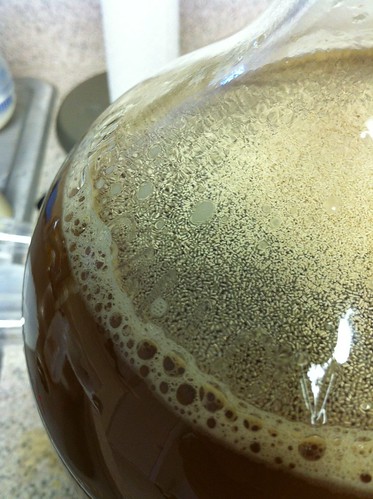
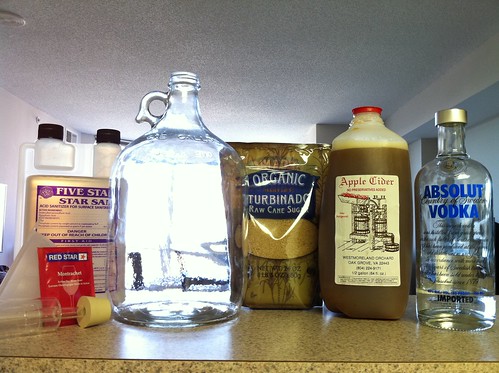
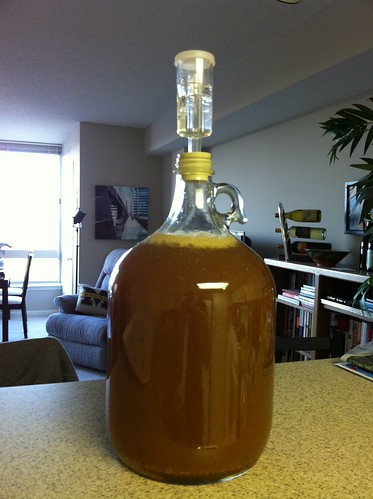
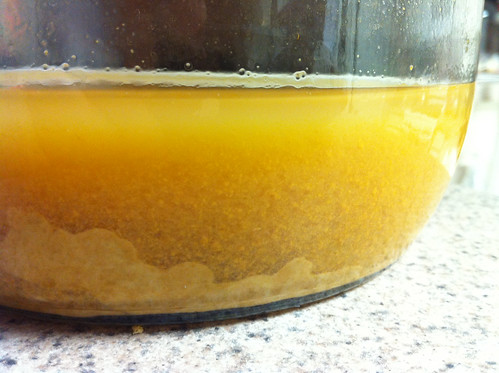
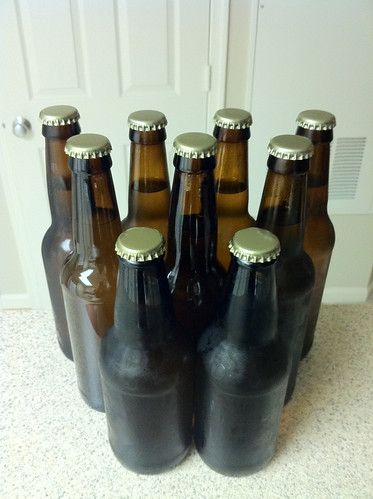
Pingback: Tweets that mention We Love Drinks: Homebrew Your Own Hard Cider » We Love DC -- Topsy.com
I would strongly suggest you NOT use supermarket cider. Cidering apples are very different creatures than snacking apples. Hard cider is a mix of cultivars chosen for specific traits: sweet, tart (acidity), aroma, flavor, etc. With normal cider, there is surprisingly little apple flavor left after fermentation; I have had to mix the final product with a shot of raw cider to bring back its apple-ness.
Distillery Lane Ciderworks in Jefferson MD can, by law, only sell unpasteurized cider to “winemakers” (coughcough), so bring your carboy.
One more tip: if you plan to do this regularly, buy some cheap, rot-gut vodka for the airlock and pour the shot of top-shelf stuff down your throat.
@FN: Ah, these are very salient points, thanks for bring them up. I’m newer to this, so your suggestions are well-taken. I’ll make an update to the post to reflect this.